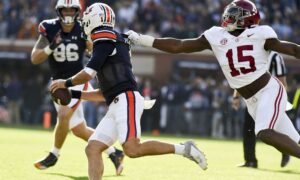Greats of the Game: Jeff Tefertiller

I play in way too many dynasty leagues. There…I said it! Managing over a dozen dynasty teams certainly can be a burden at times, but that’s for another article. One of the huge benefits I’ve found of playing in so many leagues and against so many other dynasty players is the exposure I’ve had to a variety of approaches to building, managing and adjusting a dynasty roster.
I don’t think this needs to be said, but just in case, I want to make this clear. Writing for an excellent site like Dynasty League Football, or any other prestigious fantasy site does not make us special. It doesn’t automatically give us some great all-knowing fantasy prowess that we can hold over those non-writers. Like I said, that’s obvious.
I’m lucky enough to play in leagues with fantasy writers from all different sites and some of the most well known names in the industry, but those aren’t always the ones who are winning the league. In fact, some of the best and most successful players in my leagues are people you may have never heard of, or fantasy writers who don’t always get the credit they deserve.
Ten years ago, I began a series of dynasty leagues called the HyperActive leagues and they have grown far beyond my expectations. I recently questioned four participants and past champions of the HyperActive leagues about what exactly it is that has made them so successful in these, and other dynasty leagues. While exact record keeping of the leagues has not been my strong suit, I feel very confident in saying these four are among the elite dynasty players I have come across in this hobby, and I consider them among the Greats in the Game!
[inlinead]I asked each of the four the same questions and, while they all deserve plenty of praise and credit, this article is meant to be more of a learning tool about the varying strategies that have led to their success rather than personal profiles.
For this first edition, I spoke with Jeff Tefertiller. Jeff is a good friend of mine and a staff writer for FootballGuys.com, with a focus on dynasty content. I can safely say Jeff has taught me more about dynasty fantasy football than any other person in the industry, and the fact that he has multiple championships in the HyperActive Dynasty leagues doesn’t hurt.
DLF: How would you describe your general dynasty mindset or strategy?
JT: I am usually aggressive in dynasty leagues. Only the top two or three teams finish in positive money so there is no reason to finish in the middle of the pack. Further, it is better to finish last than fourth place, in my opinion. I do not advocate tanking in any way. The league must have integrity. However, if your team is mid-pack for a couple of seasons, it is time to make some decisions. Either make trades to “win now” or go into “rebuild” mode. Either extreme is better than a first-round playoff loss for several years in a row.
DLF: What is your typical plan of attack in a dynasty startup draft?
JT: I seek value. I worry less about positional balance and most about finding quality players. Too many go into startups wanting a certain position by X round. It is okay to wait on quarterback and get stuck with Ben Roethlisberger and Joe Flacco if it means you gain value at the other position. It is okay to have Jordan Reed and Larry Donnell at tight end if you are strong at the other positions. Also, be very knowledgeable about the ADP so you can find value. Use the ADP to run through several mock drafts to get a feel for which players are available at what spot.
DLF: What advice would you give to other dynasty players when it comes to making trades in dynasty leagues?
JT: Studs win championships. After the top four or five at any position, the marginal points per game differences are minimal. Usually, the teams with the most studs are very successful. This is where 3-for-1 trades (even if you get lesser value) are advantageous. The majority of players we carry on dynasty are very replaceable.
DLF: What is unique about how you manage the “day to day” operations of your dynasty teams?
JT: I am very familiar with the depth charts of all the NFL teams. I have made it a practice to know and understand the depth charts. Then, I use this filter to watch games. It allows me to know who could benefit from injury or strong play. This goes along with roster management, another huge part of success in dynasty leagues.
DLF: What is a strategy you use in any aspect of dynasty fantasy leagues that you would recommend to all dynasty players?
JT: Try to swim upstream from the other owners in your league. For example, there is currently a huge push for young wide receivers in most leagues. You have the choice to get caught up in that marketplace or consider receivers who are older at a huge discount. This same trend allows running backs to be cheaper than in the past because of the perceived shorter career. I say perceived since the goal is to maximize the years of top production. So, a question might arise between two players, e.g. Sammy Watkins and Jeremy Hill. Hill is cheaper and there is no guarantee Watkins has more elite seasons. But, this also means that your roster should have plenty of fliers that are young wide receivers. You want bench players who could have value. So, in short: take advantage of the preferences in your league. But, remember that every league is different.
DLF: What is the one thing that has set you apart and led to your level of success in dynasty leagues?
JT: I am very active on the waiver wire, trying to upgrade the bottom of my roster. There are many situations I avoid (certain positions on certain teams) because there is little upside. So, my roster moves are usually concentrated on upside. There is no reason to roster a player you would never start regardless of the circumstances.
Takeaways
As always, I’ve learned some things from Jeff here. Actually, I’ve been reminded of some great points we’ve discussed in the past. I love that the focus of so many of his responses centered around the stud players in dynasty football, the true difference makers, but Jeff also realized the importance of managing the end of your roster. After all, some of those fliers we grab off the waiver wire could someday become the difference makers on our team.
Jeff also keyed in on an upcoming topic in my Dynasty Blueprint series- consolidation trades. Moving three players for one is getting more and more difficult as leaguemates are wary of giving up the best player in the deal, but don’t be afraid to make such a strong offer they can’t afford to reject.
Finally, Jeff’s final point reminded me of my Roster Cloggers series. Why have a player on your roster who you can never see starting a game for you. Do you have a stacked wide receiver group and just grabbed Reggie Wayne or Wes Welker off waivers just in case they land in an ideal spot. Don’t waste your time. There are examples like these at every position, and they can be team dependent.
Next time, we’ll hear from Scott Atkins of ScoutFantasy.com to see what sets him apart in dynasty leagues.
[ad5]
- Monday Mocks: Expert 2024 Rookie Mock Draft - April 22, 2024
- Monday Mocks: 2024 Landing Spots - April 15, 2024
- Five Landing Spots That Would Tank Rookie WR Value - April 13, 2024


































































